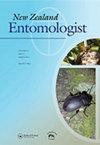濒危象甲Hadramphus tuberculatus (Pascoe, 1877)(鞘翅目:象甲科:松甲科)迁地保护的圈养
IF 0.4
4区 农林科学
Q4 ENTOMOLOGY
引用次数: 2
摘要
圈养饲养是保护濒临灭绝物种的一种成功的短期策略,通过增加现有种群或建立新的种群。提高圈养饲养的成功率需要事先具备特定的生态知识,例如栖息地和气候要求。在这里,我们报告了极度濒危的坎特伯雷象鼻虫Hadramphus tuberculatus (Pascoe, 1877)的圈养饲养。已知的结核分枝杆菌只有一个种群,估计种群规模不到100只;因此,圈养饲养提供了增加剩余种群的机会,如果能找到合适的地点,还可能允许建立新的种群。我们成功饲养了2只F1代成虫,并在项目结束时回收了2只活幼虫。我们使用定性的空间分析来确定结核分枝杆菌重新引入的可能地点的位置。空间分析表明,结核分枝杆菌新种群的适宜生境已所剩无几。我们的研究为未来的圈养繁殖计划提供了指导方针,并强调了从已经脆弱的小种群中移除个体的风险。本文章由计算机程序翻译,如有差异,请以英文原文为准。
Captive rearing of the endangered weevil Hadramphus tuberculatus (Pascoe, 1877) (Coleoptera: Curculionidae: Molytinae) for ex-situ conservation
ABSTRACT Captive rearing can be a successful short-term strategy for protecting species threatened with extinction, by bolstering existing populations, or establishing new ones. Improving the success of captive rearing requires specific prior ecological knowledge, for example habitat and climatic requirements. Here, we report on the captive rearing of the critically endangered Canterbury knobbled weevil Hadramphus tuberculatus (Pascoe, 1877). Only a single population of H. tuberculatus is known, with an estimated population size of fewer than 100 individuals; as such, captive rearing provides an opportunity to augment the remaining population and potentially to allow the establishment of new populations, if suitable sites can be found. We successfully reared two F1 generation adults and two live larvae were recovered at the end of the project. We use a qualitative spatial analysis to determine the location of possible sites for reintroduction of H. tuberculatus. The spatial analysis suggests that there is little suitable habitat remaining for new H. tuberculatus populations. Our study provides guidelines for future captive breeding programmes and highlights the risks of removing individuals from an already vulnerable, small population.
求助全文
通过发布文献求助,成功后即可免费获取论文全文。
去求助
来源期刊

New Zealand Entomologist
ENTOMOLOGY-
CiteScore
0.70
自引率
33.30%
发文量
3
审稿时长
>12 weeks
期刊介绍:
The invertebrate diversity of New Zealand is of great interest worldwide because of its geographic isolation and geological history. The New Zealand Entomologist plays an important role in disseminating information on field-based, experimental, and theoretical research.
The New Zealand Entomologist publishes original research papers, review papers and short communications. We welcome submissions in all aspects of science regarding insects and arthropods in a New Zealand or Australasian setting. The journal’s subject matter encompasses taxonomy, phylogenetics, biogeography, biological control and pest management, conservation, ecology and natural history.
The journal is the official publication of the Entomological Society of New Zealand. Papers published or submitted elsewhere for publication will not be considered, but publication of an abstract or summary elsewhere (e.g. conference proceedings) does not preclude full publication in the New Zealand Entomologist. Accepted papers become copyright of the Entomological Society of New Zealand. The journal is published in English, but we also welcome publication of abstracts in Maori.
 求助内容:
求助内容: 应助结果提醒方式:
应助结果提醒方式:


